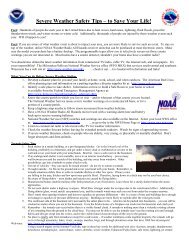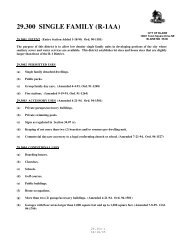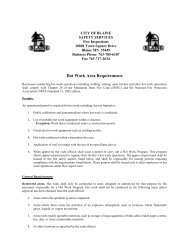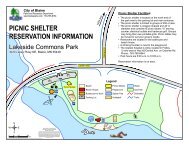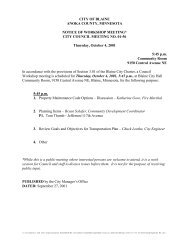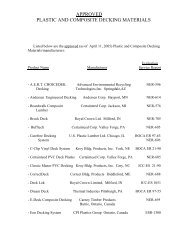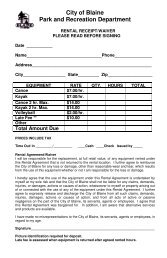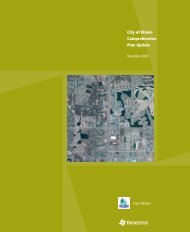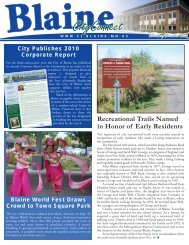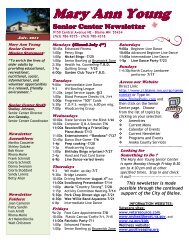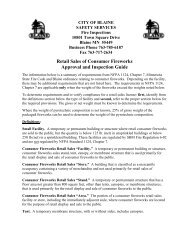Fire Safety Evacuation Planning
Fire Safety Evacuation Planning
Fire Safety Evacuation Planning
You also want an ePaper? Increase the reach of your titles
YUMPU automatically turns print PDFs into web optimized ePapers that Google loves.
CITY OF BLAINE<br />
SAFETY SERVICES<br />
<strong>Fire</strong> Inspections<br />
10801 Town Square Drive<br />
Blaine MN 55449<br />
Business Phone 763-785-6187<br />
Fax 763-717-2634<br />
FIRE SAFETY AND EVACUATION PLANNING FOR ASSEMBLY OCCUPANCIES<br />
An approved fire safety and evacuation plan shall be prepared and maintained for<br />
all Assembly Occupancies.*<br />
*(Exception) – Occupancies used exclusively for the purposes of religious<br />
worship that have an occupant load less than 2,000.<br />
<strong>Fire</strong> <strong>Evacuation</strong> Plans Shall Include The Following:<br />
1. Emergency egress or escape routes.<br />
2. Procedures for accounting for employees and occupants after the evacuation has been<br />
completed.<br />
3. Identification and assignment of personnel responsible for rescue and emergency medical<br />
care.<br />
4. The preferred and any alternate means of notifying occupants of a fire or emergency.<br />
5. The preferred and any alternate means of reporting fires and other emergencies to the fire<br />
department or the police department.<br />
6. Identification and assignment of personnel who can be contacted for further information<br />
or explanation of duties under the plan.<br />
7. A description of the emergency voice / alarm communication system alert tone and<br />
preprogrammed voice messages, where provided.<br />
<strong>Fire</strong> <strong>Safety</strong> Plans Shall Include The Following:<br />
1. The procedure for reporting a fire or other emergency.<br />
2. The life-safety strategy and procedures for notifying, relocating, or evacuating occupants.<br />
3. Site plans indicating the following:<br />
• The occupancy assembly point<br />
• The locations of fire hydrants.<br />
• The normal routes of fire department vehicle access.
4. Floor plans identifying the locations of the following<br />
• Exits<br />
• Primary evacuation routes<br />
• Secondary evacuation routes<br />
• Accessible egress routes<br />
• Areas of refuge<br />
• Manual fire alarm boxes<br />
• Portable fire extinguishers<br />
• Occupant-use hose stations<br />
• <strong>Fire</strong> alarm annunciators and controls<br />
5. A list of major fire hazards associated with the normal use and occupancy of the<br />
premises, including maintenance and housekeeping procedures.<br />
6. Identification and assignment of personnel responsible for the maintenance of systems<br />
and equipment installed to prevent or control fires.<br />
7. Identification and assignment of personnel responsible for the maintenance,<br />
housekeeping and controlling fuel hazard sources.<br />
8. A detailed seating plan showing exit paths and exit doors.<br />
9. Posted occupant load limit signs.<br />
<strong>Fire</strong> safety and evacuation plans shall be reviewed or updated annually or as<br />
necessitated by changes in staff assignments, occupancy, or the physical<br />
arrangement of the building.<br />
<strong>Fire</strong> safety and evacuation plans shall be available in the workplace for reference<br />
and review by employees, and copies shall be furnished to the fire inspector for<br />
review upon request.<br />
Emergency <strong>Evacuation</strong> Drills:<br />
Assembly Occupancies are required to hold fire evacuation drills quarterly for<br />
their employees. Responsibility for the planning and conduct of the drills shall be<br />
assigned to competent personsdesignated to exercise leadership.<br />
Drills shall be held at unexpected times and under varying conditions to simulate<br />
the unusual conditions that occur in case of fire.<br />
Records shall be maintained of required emergency evacuation drills and should<br />
include the following information:<br />
• Identity of the person conducting the drill.<br />
• Date and time of the drill.<br />
• Notification method used.<br />
• Staff members on duty and participating.<br />
• Number of occupants evacuated.<br />
• Special conditions simulated.<br />
• Problems encountered.
• Weather conditions when occupants were evacuated.<br />
• Time required to accomplish complete evacuation.<br />
Where a fire alarm is provided, emergency evacuation drills shall be initiated by<br />
activating the fire alarm system.<br />
As building occupants arrive at the assembly point, efforts shall be made to<br />
determine if all the occupants have been successfully evacuated or accounted for.<br />
Employee Training and Response Procedures:<br />
Employees in assembly occupancies shall be trained in the fire emergency<br />
procedures described in their fire evacuation and fire safety plans. Employees<br />
shall receive training in the contents of fire safety and evacuation plans and their<br />
duties as part of new employee orientation and at least annually thereafter.<br />
Records shall be kept and made available to the fire inspector upon request.<br />
Employees shall be trained in fire prevention, evacuation and fire safety.<br />
Employees shall be apprised of the fire hazards of the materials and processes to<br />
which they are exposed. Each employee shall be instructed in the proper<br />
procedures for preventing fires in the conduct of their duties. Employees shall be<br />
familiar with the fire alarm and evacuation signals, their assigned duties in the<br />
event of an alarm or emergency,evacuation routes, areas of refuge, exterior<br />
assembly areas, and procedures for evacuation. Employees assigned to<br />
firefighting duties shall be trained to know the locations and proper use of<br />
portable fire extinguishers or other fire-fighting equipment.<br />
i:\fireinsp\blaine policies-handouts\fire safety evacuation planning assembly.doc



